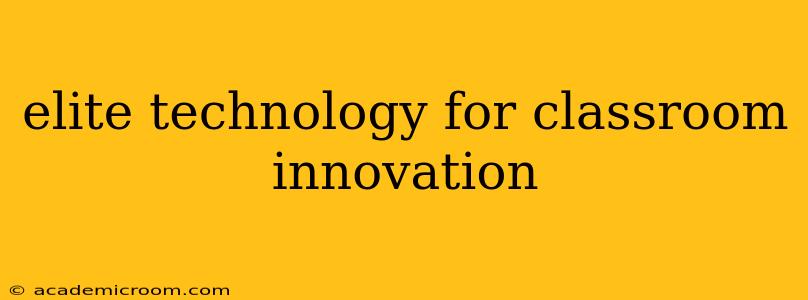The modern classroom is undergoing a dramatic transformation, fueled by the integration of elite technology. No longer a futuristic fantasy, cutting-edge tools are revolutionizing how students learn and teachers teach, fostering a more engaging, effective, and accessible educational experience. This exploration delves into the exciting world of elite classroom technology, examining its impact and potential.
What are some examples of elite classroom technology?
Elite classroom technology encompasses a wide range of tools designed to enhance learning outcomes. This includes:
-
Interactive Whiteboards: These dynamic displays go beyond traditional chalkboards, allowing teachers to incorporate multimedia content, interactive games, and collaborative activities. They foster active participation and cater to diverse learning styles.
-
Virtual and Augmented Reality (VR/AR): Immersive technologies like VR and AR offer unparalleled opportunities for experiential learning. Students can virtually explore historical sites, dissect a frog without harming a creature, or travel to distant planets – all within the safety and convenience of the classroom.
-
Robotics and Coding Platforms: Hands-on learning with robotics kits and coding platforms encourages problem-solving, critical thinking, and computational skills. Students build, program, and troubleshoot robots, gaining valuable STEM skills in a fun and engaging way.
-
Adaptive Learning Platforms: These sophisticated systems personalize learning paths based on individual student needs and progress. They identify learning gaps and provide targeted support, ensuring every student receives the appropriate level of challenge and assistance.
-
Learning Management Systems (LMS): Centralized platforms like Canvas, Moodle, and Blackboard streamline communication, assignment submission, and grade tracking. They provide a single hub for all course materials and facilitate seamless interaction between students and teachers.
-
3D Printers: Allowing students to design and create physical objects brings learning to life. From engineering prototypes to artistic models, 3D printing fosters creativity and problem-solving skills.
How can elite technology improve student engagement?
Elite technology significantly boosts student engagement by:
-
Creating Interactive Experiences: Interactive whiteboards, VR/AR, and gamified learning platforms actively involve students in the learning process, making it more exciting and less passive.
-
Catering to Diverse Learning Styles: Technology offers varied learning modalities, catering to visual, auditory, and kinesthetic learners. This ensures that every student has access to learning materials presented in a way they can easily understand and process.
-
Providing Personalized Learning: Adaptive learning platforms tailor the learning experience to individual student needs, addressing learning gaps and providing targeted support. This personalized approach fosters a sense of ownership and accomplishment.
-
Promoting Collaboration: Many technologies facilitate collaboration, allowing students to work together on projects, share ideas, and learn from one another. This collaborative environment enhances social skills and teamwork.
What are the challenges of implementing elite technology in classrooms?
While the benefits of elite technology are undeniable, several challenges exist:
-
Cost: Implementing advanced technologies can be expensive, requiring significant investments in hardware, software, and teacher training.
-
Teacher Training: Effective utilization of technology requires adequate teacher training and ongoing support. Teachers need the skills and confidence to integrate these tools effectively into their teaching practice.
-
Digital Divide: Ensuring equitable access to technology for all students is crucial. The digital divide, where some students lack access to technology at home or school, must be addressed to prevent inequality in educational opportunities.
-
Technical Issues: Technology can malfunction, leading to disruptions in teaching and learning. Robust IT support and contingency plans are essential to minimize downtime.
What are the future trends in elite classroom technology?
The future of classroom technology is bright, with several exciting trends on the horizon:
-
Artificial Intelligence (AI): AI-powered tools will personalize learning even further, providing real-time feedback and adapting to individual student needs.
-
Increased Accessibility: Technology will continue to enhance accessibility for students with disabilities, providing personalized support and tailored learning experiences.
-
Greater Integration: Different technologies will become more seamlessly integrated, creating a unified and cohesive learning environment.
-
Focus on Soft Skills: Technology will increasingly support the development of essential soft skills, such as collaboration, communication, and critical thinking.
How does elite technology help teachers?
Elite classroom technology provides numerous benefits for teachers, including:
-
Increased Efficiency: Automating tasks such as grading and communication frees up teachers' time to focus on individual student needs and curriculum development.
-
Data-Driven Insights: Technology provides data on student progress, allowing teachers to identify learning gaps and tailor their instruction accordingly.
-
Enhanced Engagement: Engaging technology tools make teaching more interactive and enjoyable for teachers, leading to increased job satisfaction.
In conclusion, elite technology is transforming education by fostering innovative teaching practices, enhancing student engagement, and creating more personalized and accessible learning experiences. While challenges remain, the potential benefits of this transformative technology are enormous, paving the way for a more effective and engaging future of learning.
